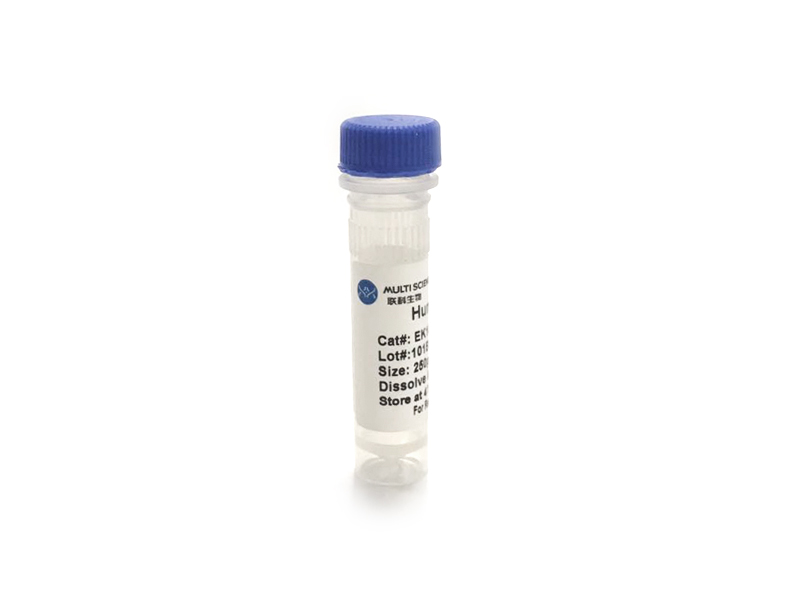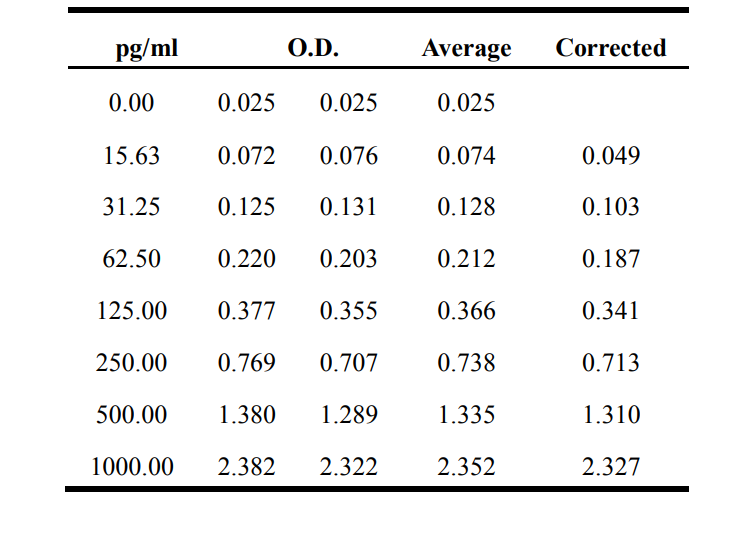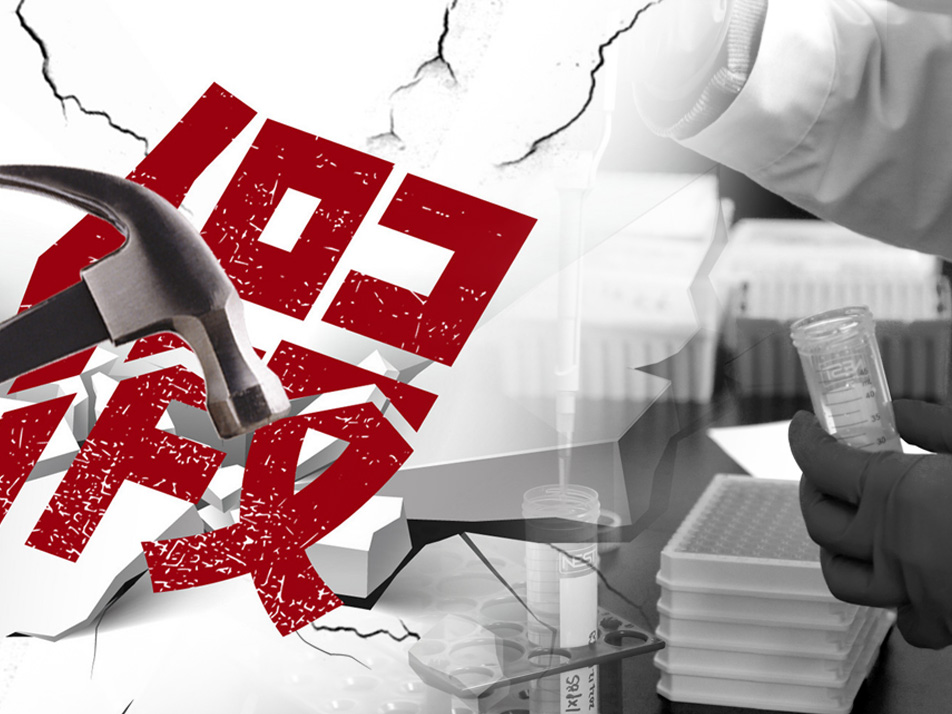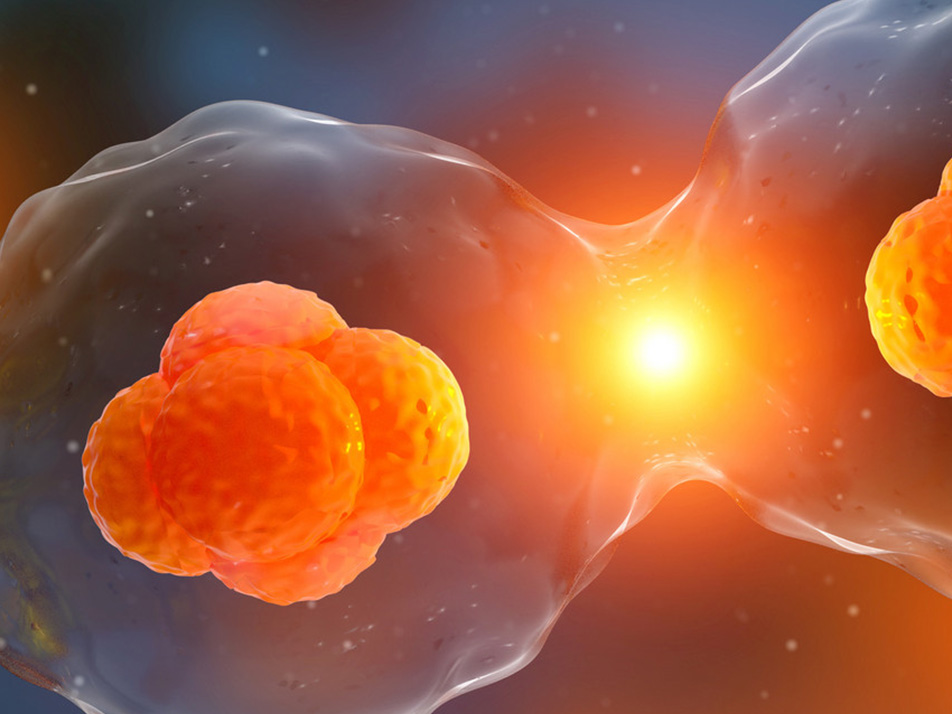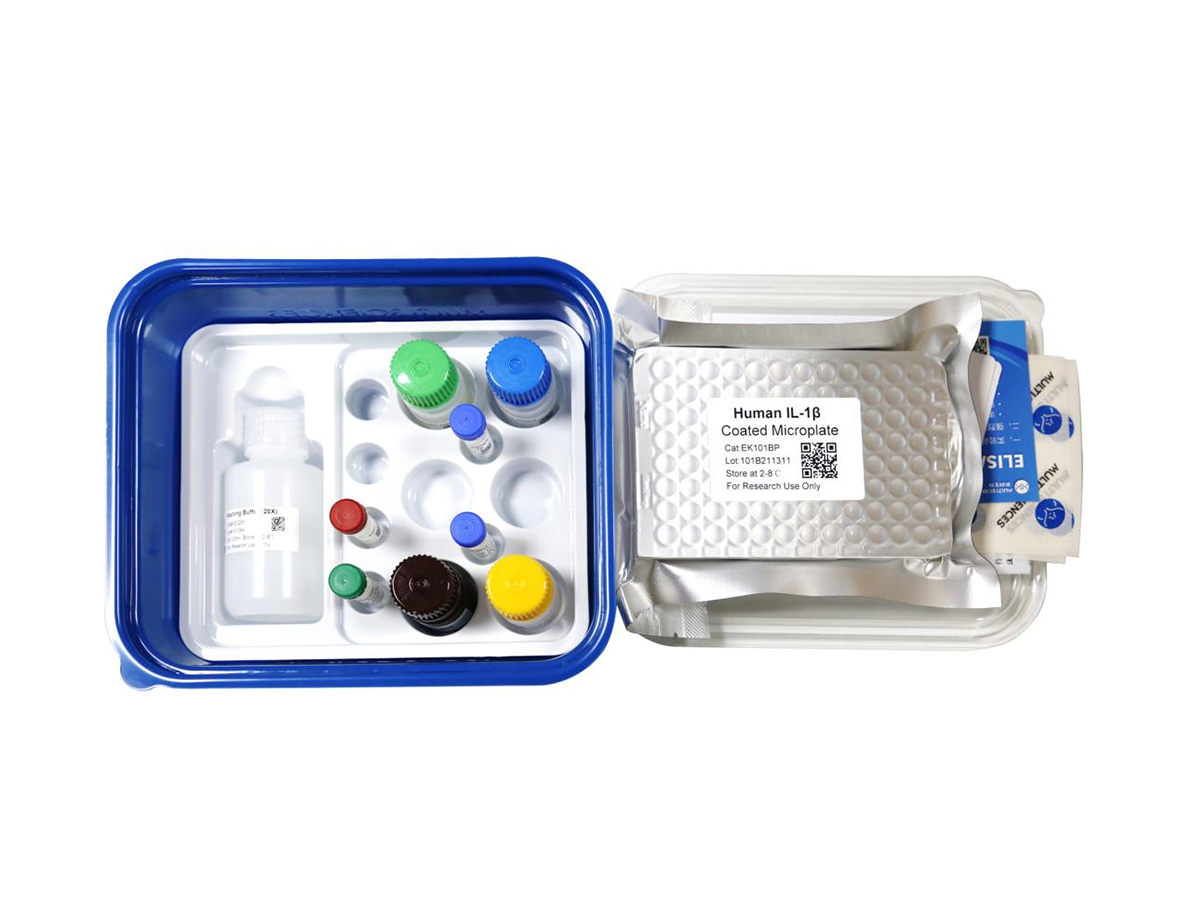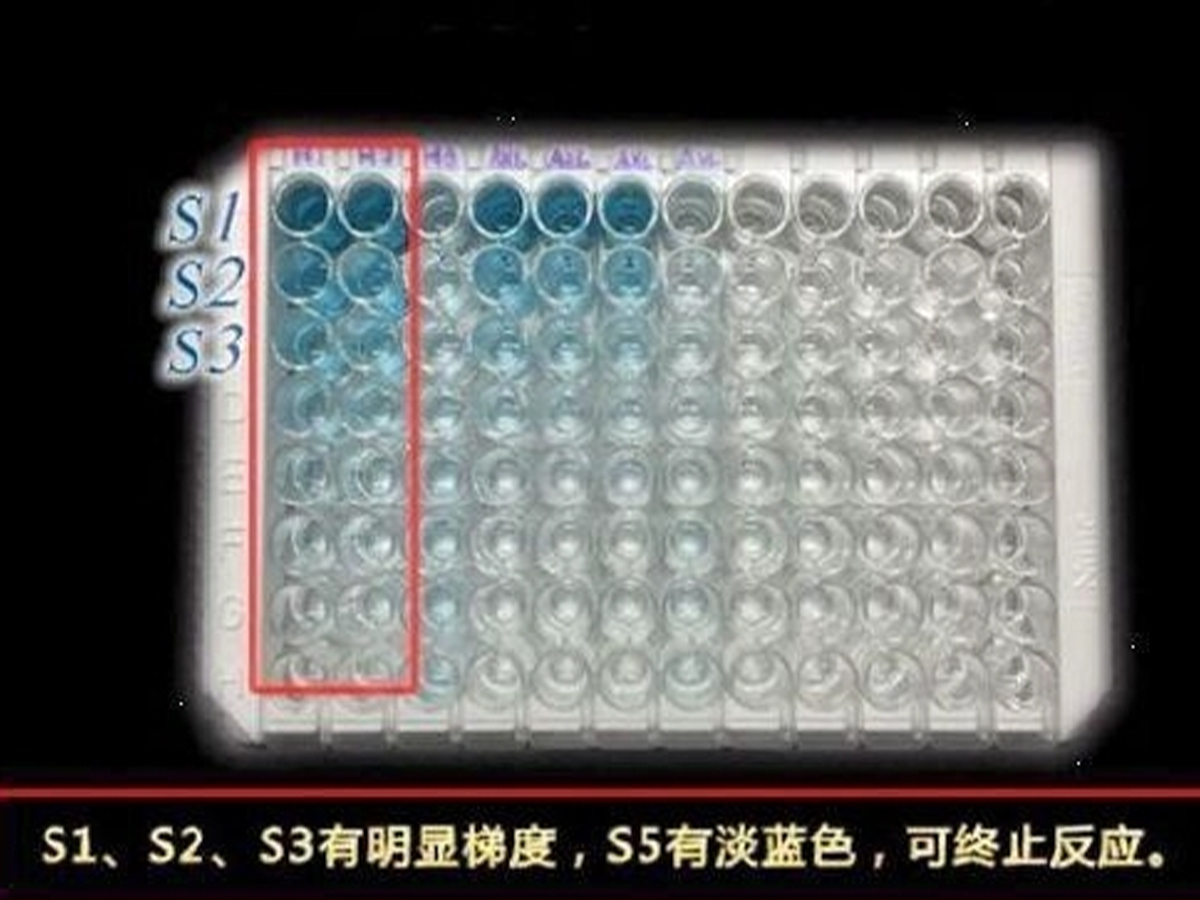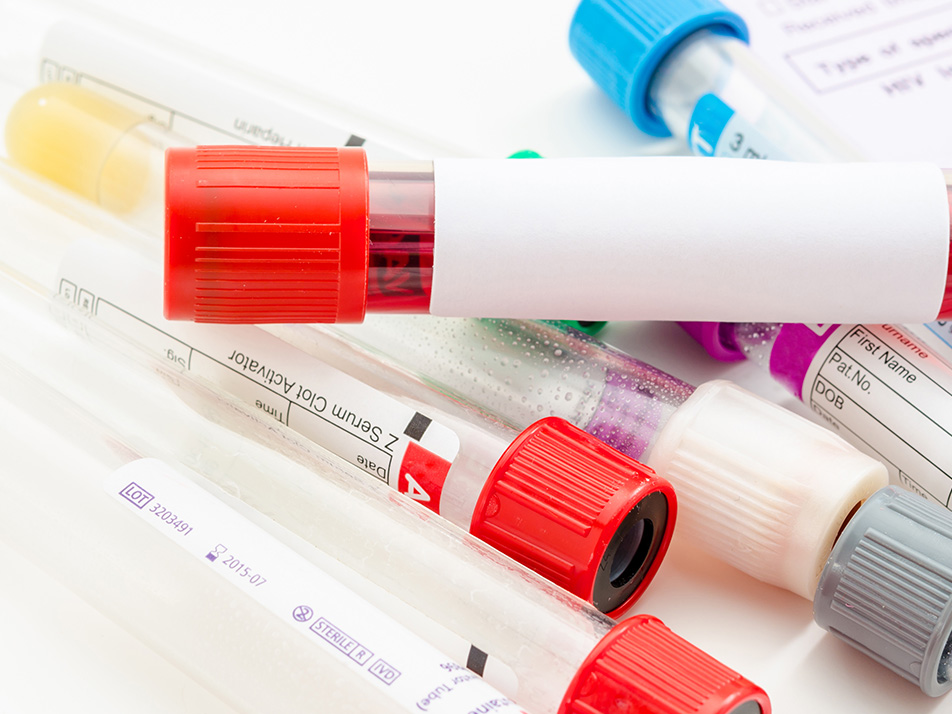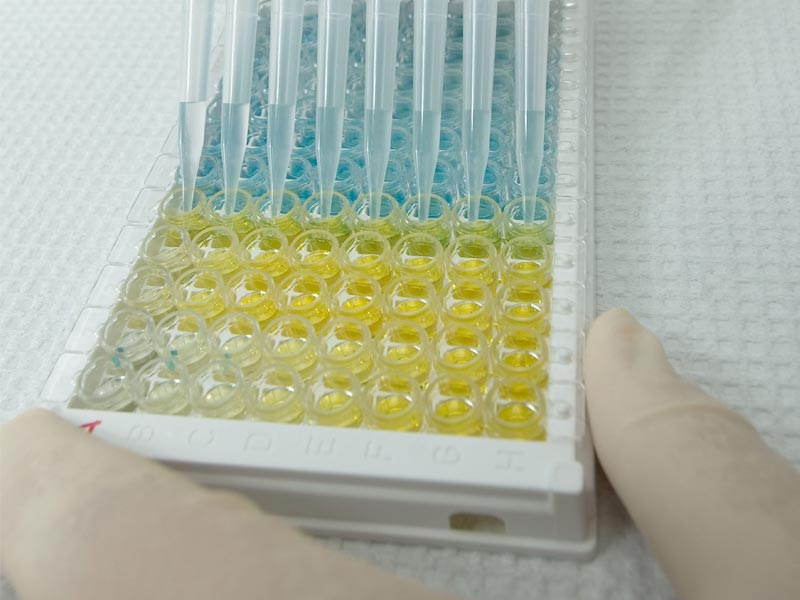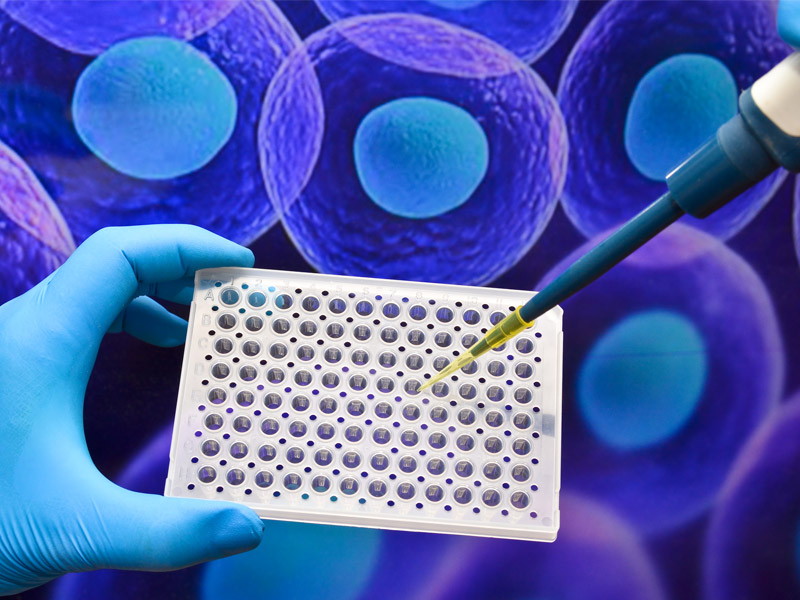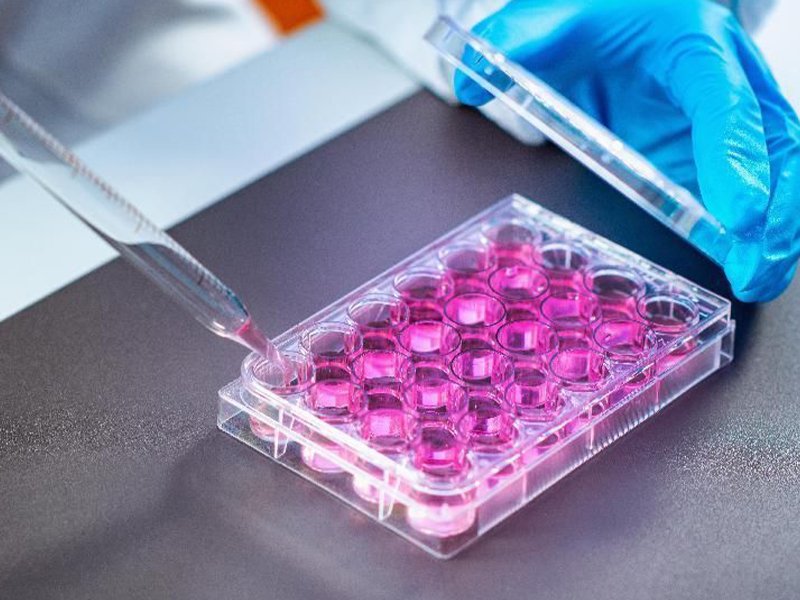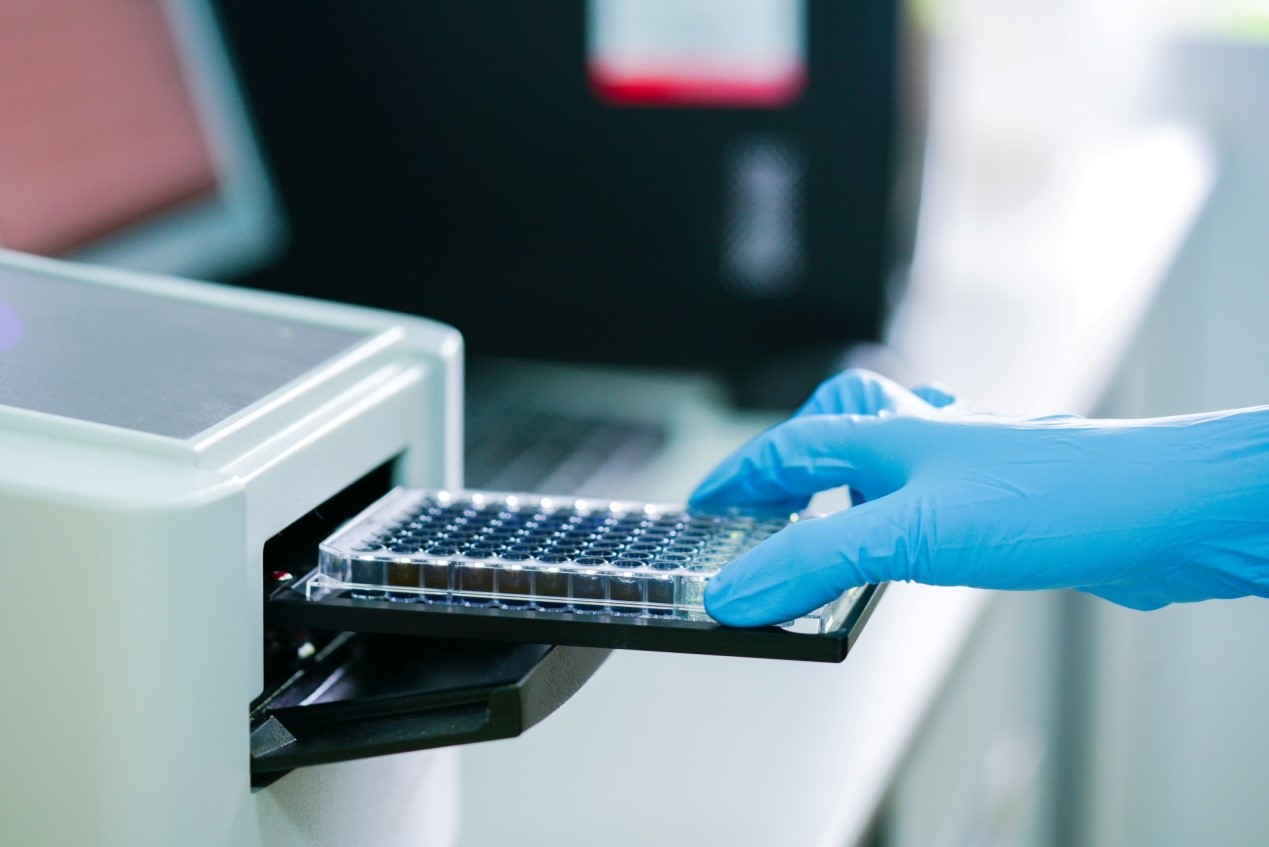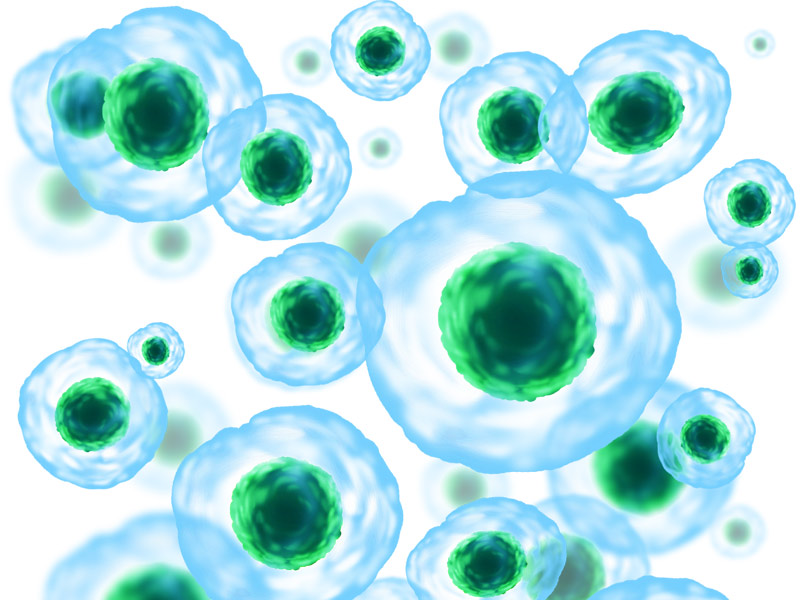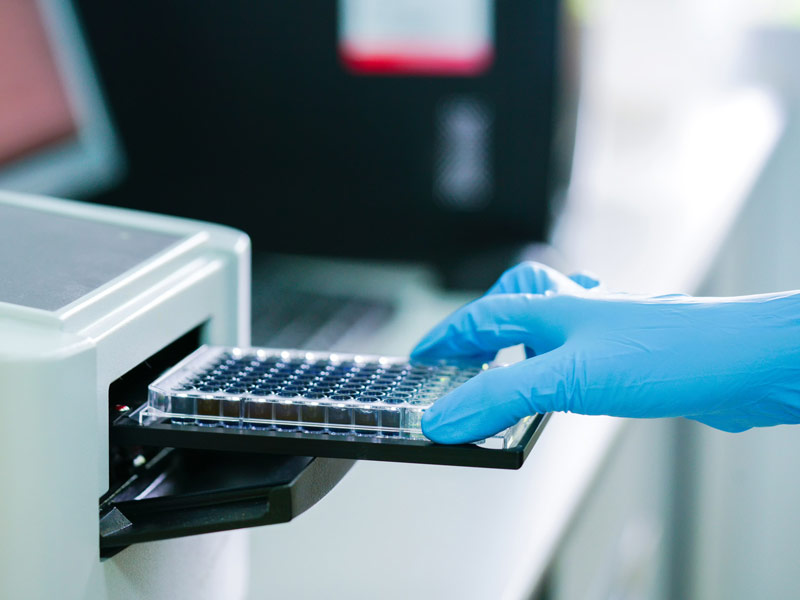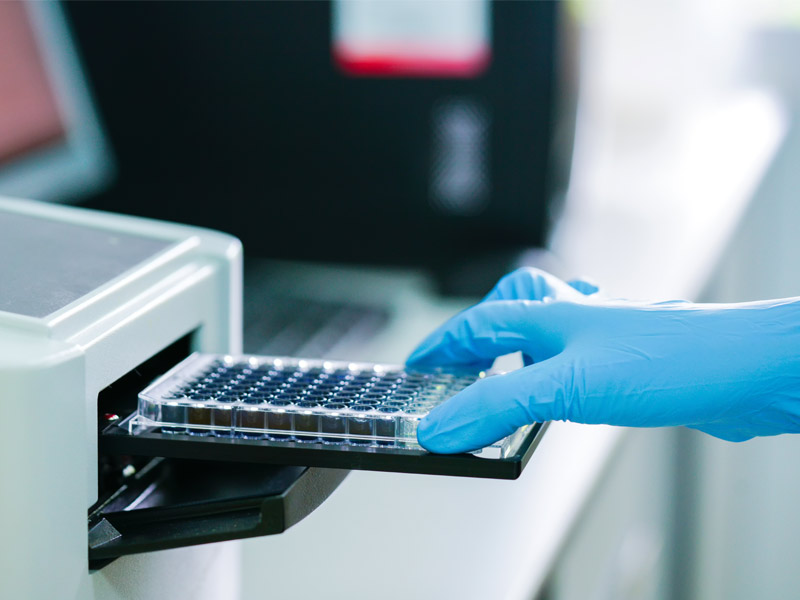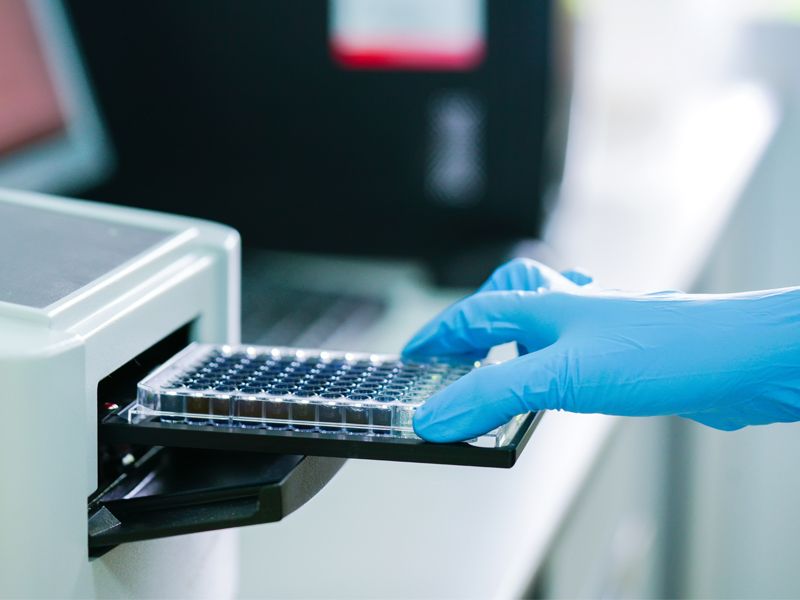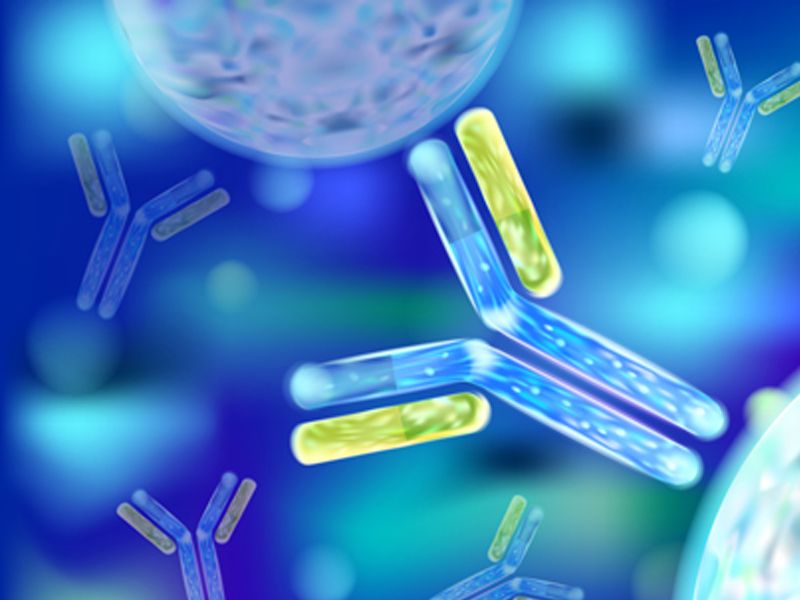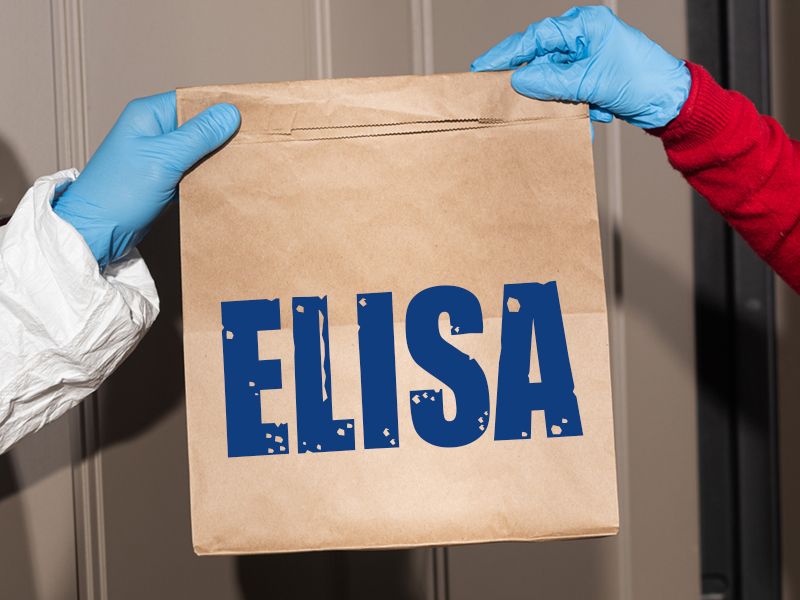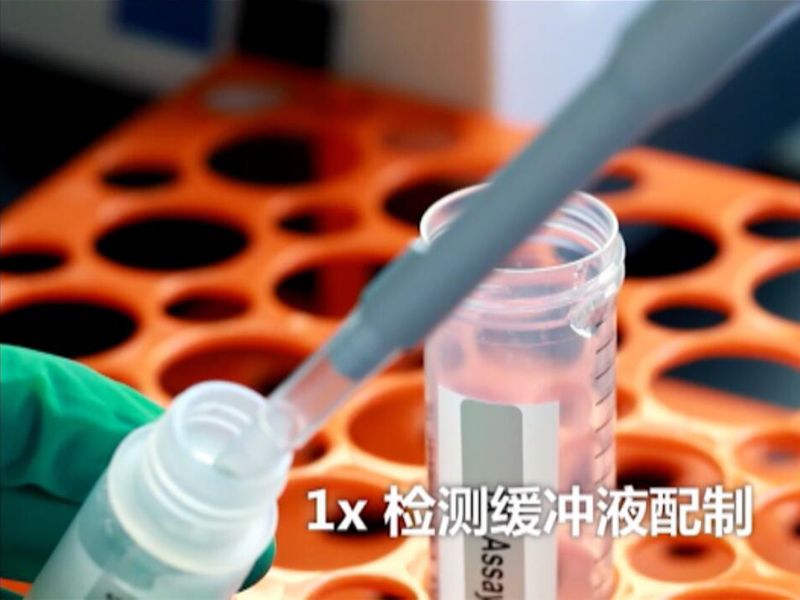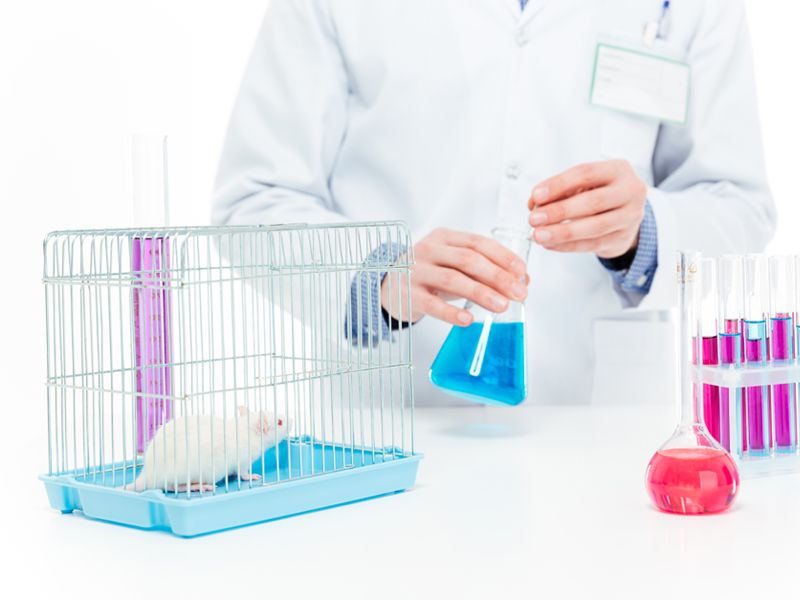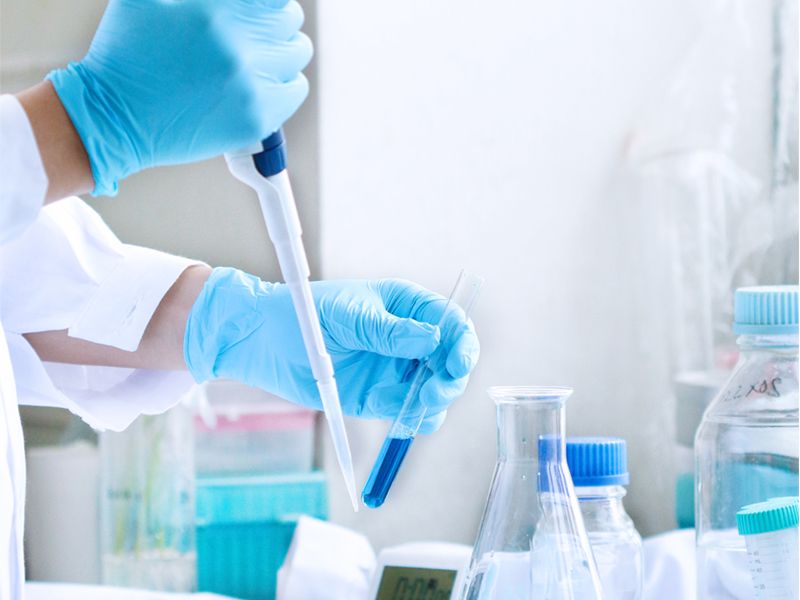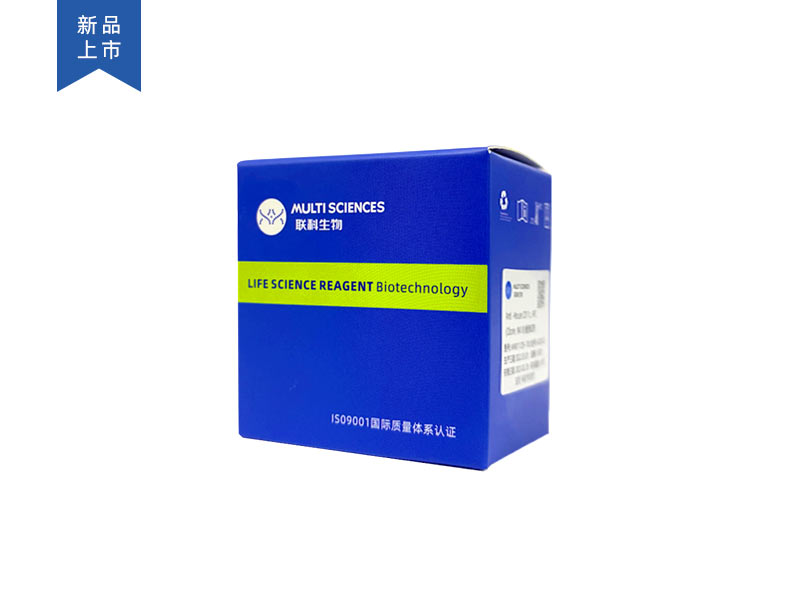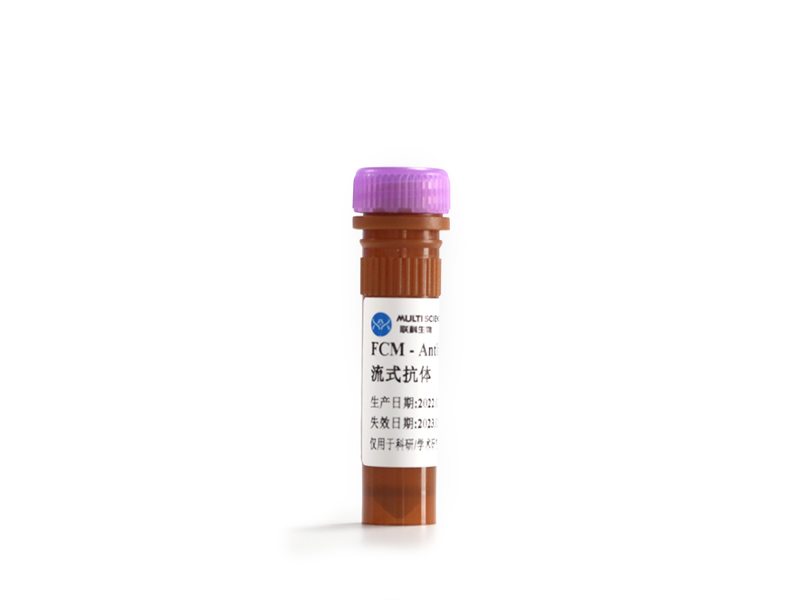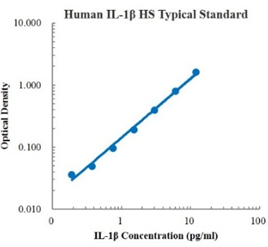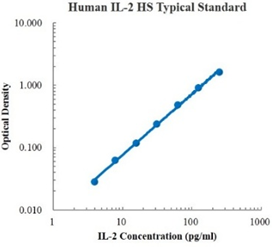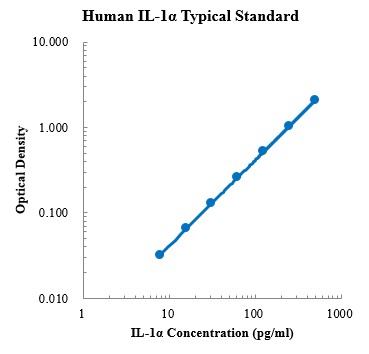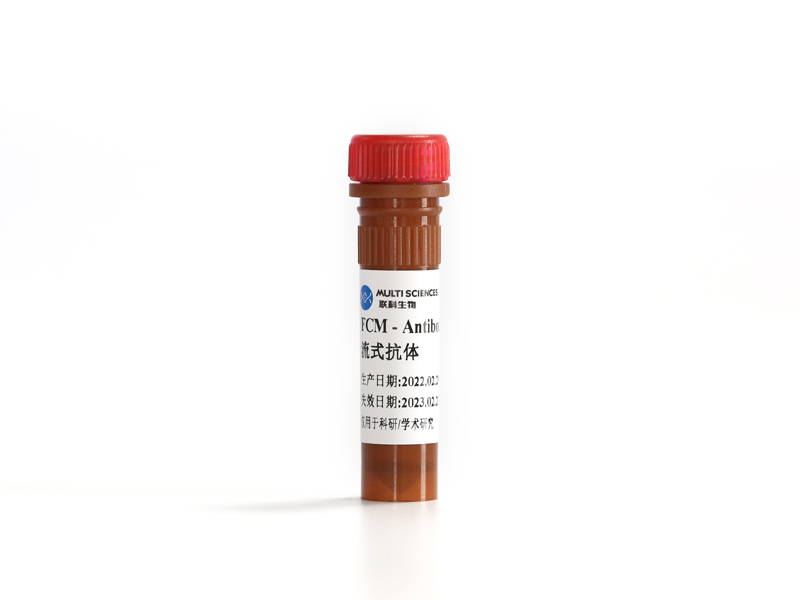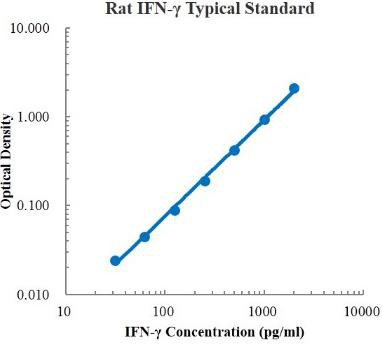Human IFN-γ Standard (人γ干扰素标准品)
¥580.00
描述
文章目录[隐藏]
本产品只包含标准品试剂,如需购买试剂盒请点击下图
-
- EK180 169 Citations
- ELISA试剂盒
Human IFN-gamma ELISA Kit检测试剂盒(酶联免疫吸附法)
- ¥1,600.00 – ¥10,800.00
| 商品名 |
Human IFN-γ Standard (人γ干扰素标准品) |
|---|---|
| 组分 |
人IFN-γ标准品 |
| 检测方法 |
双抗夹心法 |
| 样本类型 |
血清,血浆,细胞培养上清及其他生物学样本 |
| 板式 |
管 |
| 保存 |
短期4℃,长期-20℃保存 |
| 运输条件 |
4℃蓝冰运输 |
检测原理:本试剂盒采用双抗体夹心酶联免疫吸附检测技术。特异性抗人IFN-γ抗体预包被在高亲和力的酶标板上。酶标板孔中加入标准品、待测样本和生物素化的检测抗体,经过孵育,样本中存在的IFN-γ与固相抗体和检测抗体结合。洗涤去除未结合的物质后,加入辣根过氧化物酶标记的链霉亲和素(Streptavidin-HRP)。洗涤后,加入显色底物TMB,避光显色。颜色反应的深浅与样本中IFN-γ的浓度成正比。加入终止液终止反应,在450 nm波长(参考波长570 - 630 nm)测定吸光度值。
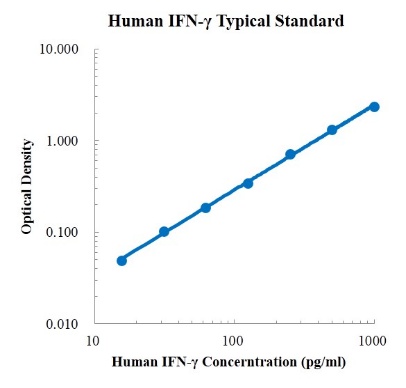
分子信息
IFNG 分子靶点信息概述
- 分子名:IFNG, interferon gamma
- 基因家族:Interferons
IFNG 分子靶点综述
IFN-γ主要由Th1型细胞产生,属于II型细胞因子中干扰素家族中的一员,是一类分泌型糖蛋白,由143个氨基酸组成,相对分子质量是16942。IFN-γ主要由活化的T细胞和NK细胞产生,具有调节机体免疫状态,介导细胞免疫,加强受体介导的吞噬功能,增强巨噬细胞和中性粒细胞的杀伤活性,具有抗病毒感染及抗肿瘤等生物学活性。
人 Human IFNG 分子靶点信息
- 分子名:IFNG, interferon gamma
- 别称:
- IFG
- IFI
- IFN-gamma
- IMD69
- immune interferon
- interferon, gamma
- 基因序列:NCBI_Gene: 3458
- 蛋白序列:UniProtKB: P01579
人 Human IFNG靶点分子功能(预测)
Predicted to enable cytokine activity. Involved in several processes, including positive regulation of cell death; positive regulation of cell differentiation; and positive regulation of macromolecule metabolic process. Acts upstream of or within several processes, including positive regulation of gene expression; positive regulation of protein phosphorylation; and response to virus. Located in extracellular region. Implicated in several diseases, including ataxia telangiectasia; autoimmune disease (multiple); eczema herpeticum; factor VIII deficiency; and leukemia (multiple). Biomarker of several diseases, including acute retinal necrosis syndrome; allergic rhinitis; autoimmune disease (multiple); nephritis (multiple); and otitis media (multiple).
引用文献统计
该产品被引用的文献总数为:0
暂无相关文献引用。
ELISA标准品操作常见问题查看更多ELISA标准品操作步骤技术文章
查看更多ELISA标准品操作步骤技术文章
操作步骤
文章目录[隐藏]
- ELISA操作常见问题
- 小心!你的 ELISA 试剂盒可能是假的
- 开学学习计划,如何收集ELISA检测样本——细胞
- 开学学习计划,如何选择ELISA试剂盒
- 开学学习计划,ELISA从新手到入门!
- 一文掌握ELISA实验显色判断、数据分析及标曲拟合
- 血清OR血浆,哪个是ELISA的菜
- ELISA通关必备丨数据篇丨标准曲线不佳
- ELISA通关必备丨操作篇丨常见问题及解决方案
- ELISA通关必备丨操作篇丨溶解与稀释标准品
- ELISA通关必备丨样本篇丨不常见样本
- ELISA通关必备丨样本篇丨常见样本丨细胞
- ELISA通关必备丨如何选择试剂盒
- ELISA通关必备丨基础知识
- 真?假?ELISA试剂盒选择要小心
- ELISA常见类型一 | 双抗夹心法,你要的都在这里!
- ELISA常见类型二 | 竞争法,五分钟搞定!
- 叮!联科向您投递了个ELISA实验操作干货包,请查收~
- 【视频】ELISA实验操作步骤演示视频教程
- ELISA 组织样本的处理—大鼠组织
- 【视频】ELISA实验原理与常见问题分析
- 查看更多ELISA操作相关问题
ELISA操作常见问题
查看更多ELISA操作相关问题
引用文献
文章目录[隐藏]
- Construction of PD1/CD28 chimeric-switch receptor enhances anti-tumor ability of c-Met CAR-T in gastric cancer
- Involvement of impaired CD8+ mucosal-associated invariant T cells and myeloid-derived suppressor cells in polycystic ovary syndrome
- Immune Checkpoint Inhibition Overcomes ADCP-Induced Immunosuppression by Macrophages
- Role of CD8+ T cell exhaustion in the progression and prognosis of acute respiratory distress syndrome induced by sepsis: a prospective observational study
- Cytokine nanosponges suppressing overactive macrophages and dampening systematic cytokine storm for the treatment of hemophagocytic lymphohistiocytosis
- Inflammatory Cytokines Changed in Patients With Depression Before and After Repetitive Transcranial Magnetic Stimulation Treatment
- Promotion of angiogenesis in vitro by Astragalus polysaccharide via activation of TLR4 signaling pathway
- Vitamin D deficiency is associated with thyroid autoimmunity: results from an epidemiological survey in Tianjin, China
- Original research: Shed antigen-induced blocking effect on CAR-T cells targeting Glypican-3 in Hepatocellular Carcinoma
- AEG-1 silencing attenuates M2-polarization of glioma-associated microglia/macrophages and sensitizes glioma cells to temozolomide
- Progesterone-induced blocking factor-mediated Th1/Th2 balance correlates with fetal arrest in women who underwent in vitro fertilization and embryo transfer
- Reducing Hinge Flexibility of CAR-T Cells Prolongs Survival In Vivo With Low Cytokines Release
- Adoptive immunotherapy using T lymphocytes redirected to glypican-3 for the treatment of lung squamous cell carcinoma
- Development of bispecific anti-c-Met/PD-1 diabodies for the treatment of solid tumors and the effect of c-Met binding affinity on efficacy
- Preclinical characterization of a Fab-like CD3/CLDN18.2 XFab® bispecific antibody against solid tumors
- Notch1 signalling controls the differentiation and function of myeloid-derived suppressor cells in systemic lupus erythematosus
- Targeting Wnt Signaling in the Tumor Immune Microenvironment to Enhancing EpCAM CAR T-Cell therapy
- Targeting integrin αvβ3 with indomethacin inhibits patient-derived xenograft tumour growth and recurrence in oesophageal squamous cell carcinoma
- Niraparib exhibits a synergistic anti-tumor effect with PD-L1 blockade by inducing an immune response in ovarian cancer
- Construction and expression of Mycobacterium tuberculosis fusion protein AR2 and its immunogenicity in combination with various adjuvants to form vaccine
- Enhanced immunogenicity of the tuberculosis subunit Rv0572c vaccine delivered in DMT liposome adjuvant as a BCG-booster
- Human natural killer cells for targeting delivery of gold nanostars and bimodal imaging directed photothermal/photodynamic therapy and immunotherapy
- Decidua-derived granulocyte macrophage colony-stimulating factor induces polymorphonuclear myeloid-derived suppressor cells from circulating CD15+ neutrophils
- Dynamic changes of innate lymphoid cells in acute ST-segment elevation myocardial infarction and its association with clinical outcomes
- Long Noncoding RNA and Circular RNA Expression Profiles of Monocyte-Derived Dendritic Cells in Autoimmune Hepatitis
- The Effect of Entecavir Therapy on Immune Status in Chronic Hepatitis B Patients
- Interleukin-21 Inhibits HBV Replication in vitro
- Alteration of Myeloid-Derived Suppressor Cells, Chronic Inflammatory Cytokines, and Exosomal miRNA Contribute to the Peritoneal Immune Disorder of Patients With Endometriosis
- A novel bispecific antibody targeting CD3 and prolactin receptor (PRLR) against PRLR-expression breast cancer
- Elevated Peripheral Frequencies of Th22 Cells: A Novel Potent Participant in Obesity and Type 2 Diabetes
- MicroRNA 27b-3p Modulates SYK in Pediatric Asthma Induced by Dust Mites
- Cytokine-induced killer cells efficiently kill stem-like cancer cells of nasopharyngeal carcinoma via the NKG2D-ligands recognition
- JAK-STAT Domain Enhanced MUC1-CAR-T Cells Induced Esophageal Cancer Elimination
- Chimeric cytokine receptor enhancing PSMA-CAR-T cell-mediated prostate cancer regression
- Treatment of hepatocellular carcinoma with a GPC3-targeted bispecific T cell engager
- Development of GPC3 and EGFR-dual-targeting chimeric antigen receptor-T cells for adoptive T cell therapy
- Selective Targeting of Glioblastoma with EGFRvIII/EGFR Bitargeted Chimeric Antigen Receptor T Cell
- Claudin18.2-Specific Chimeric Antigen Receptor Engineered T Cells for the Treatment of Gastric Cancer
- Treatment Efficacy of Chuang Ling Ye, a Traditional Chinese Herbal Medicine Compound, on Idiopathic Granulomatous Mastitis: A Randomized Controlled Trial
- Original research: Switch receptor T3/28 improves long-term persistence and antitumor efficacy of CAR-T cells
- CD4+/CD8+ mucosa-associated invariant T cells foster the development of endometriosis: a pilot study
- Vitamin D Deficiency Contributes to the Reduction and Impaired Function of Naïve Regulatory T Cell in Chronic Heart Failure
- Simultaneous blocking of CD47 and PD-L1 increases innate and adaptive cancer immune responses and cytokine release
- A novel long-term intravenous combined with local treatment with human amnion-derived mesenchymal stem cells for a multidisciplinary rescued uremic calciphylaxis patient and the underlying mechanism
- Inverse relationship between toxic shock syndrome toxin-1 antibodies and interferon-γ and interleukin-6 in peripheral blood mononuclear cells from patients with pediatric tonsillitis caused by Staphylococcus aureus
- Differentiation of T-helper cells in distinct phases of atopic dermatitis involves Th1/Th2 and Th17/Treg
- Immunomodulatory effects of platelets on the severity of hand, foot, and mouth disease infected with enterovirus 71
- Imbalance of Th17, Treg, and helper innate lymphoid cell in the peripheral blood of patients with rheumatoid arthritis
- The Combined Use of Cytokine-Induced Killer Cells and Cyclosporine A for the Treatment of Aplastic Anemia in a Mouse Model
- Engineered IL-7 Receptor Enhances the Therapeutic Effect of AXL-CAR-T Cells on Triple-Negative Breast Cancer
- Nanobody-based CAR T cells targeting intracellular tumor antigens
- A PD-1 peptide antagonist exhibits potent anti-tumor and immune regulatory activity
- Design and Synthesis of A PD-1 Binding Peptide and Evaluation of Its Anti-Tumor Activity
- Development of T Cells Redirected to Glypican-3 for the Treatment of Hepatocellular Carcinoma
- Innate lymphoid cell disturbance with increase in ILC1 in systemic lupus erythematosus
- The preparation of N-IgY targeting SARS-CoV-2 and its immunomodulation to IFN-γ production in vitro
- MicroRNA-34a promotes MICB expression in hepatocytes
- Antitumor effect of IL-12 gene-modified bone marrow mesenchymal stem cells combined with Fuzheng Yiliu decoction in an in vivo glioma nude mouse model
- B7-H3 on breast cancer cell MCF7 inhibits IFN-γ release from tumour-infiltrating T cells
- Generation of hypoimmunogenic human pluripotent stem cells via expression of membrane-bound and secreted β2m-HLA-G fusion proteins
- HOXA11-AS1 Promotes PD-L1-Mediated Immune Escape and Metastasis of Hypopharyngeal Carcinoma by Facilitating PTBP1 and FOSL1 Association
- Disruption of PD-1 Enhanced the Anti-tumor Activity of Chimeric Antigen Receptor T Cells Against Hepatocellular Carcinoma
- Tumor cell membrane-based peptide delivery system targeting the tumor microenvironment for cancer immunotherapy and diagnosis
- Peptide Blocking of PD-1/PD-L1 Interaction for Cancer Immunotherapy
- PDL1-targeted vaccine exhibits potent antitumor activity by simultaneously blocking PD1/PDL1 pathway and activating PDL1-specific immune responses
- Design of a Novel Multi-Epitope Vaccine Against Echinococcus granulosus in Immunoinformatics
- EGFR-TKI resistance promotes immune escape in lung cancer via increased PD-L1 expression
- Tumor-Infiltrating PD-L1+ Neutrophils Induced by GM-CSF Suppress T Cell Function in Laryngeal Squamous Cell Carcinoma and Predict Unfavorable Prognosis
- Increased AHR Transcripts Correlate With Pro-inflammatory T-Helper Lymphocytes Polarization in Both Metabolically Healthy Obesity and Type 2 Diabetic Patients
- Identification of Robust Biomarkers for Early Predicting Efficacy of Subcutaneous Immunotherapy in Children With House Dust Mite-Induced Allergic Rhinitis by Multiple Cytokine Profiling
- High-Dose Aluminum Exposure Further Alerts Immune Phenotype in Aplastic Anemia Patients
- Targeting the class IA PI3K isoforms p110α/δ attenuates heart allograft rejection in mice by suppressing the CD4+ T lymphocyte response
- Wnt/β-catenin signaling mediates the abnormal osteogenic and adipogenic capabilities of bone marrow mesenchymal stem cells from chronic graft-versus-host disease patients
- Tonsillar Microbiome-Derived Lantibiotics Induce Structural Changes of IL-6 and IL-21 Receptors and Modulate Host Immunity
- Changes in peripheral blood cytokines in patients with severe fever with thrombocytopenia syndrome
- Participation of Increased Circulating MAIT Cells in Lung Cancer: a Pilot Study
- TRIM21 causes abnormal expression of IL-6 in oral lichen planus via the TRIB2-MAPK signal axis
- Impaired myeloid-derived suppressor cells are associated with recurrent implantation failure: A case-control study
- Regulation of CBL and ESR1 expression by microRNA-22‑3p, 513a-5p and 625-5p may impact the pathogenesis of dust mite-induced pediatric asthma
- Changes in circulating microRNA-126 levels are associated with immune imbalance in children with acute asthma
- ILC2s Induce Adaptive Th2-Type Immunity in Acute Exacerbation of Chronic Obstructive Pulmonary Disease
- Hyperbaric Oxygen Alleviates the Inflammatory Response Induced by LPS Through Inhibition of NF-κB/MAPKs-CCL2/CXCL1 Signaling Pathway in Cultured Astrocytes
- Increased antitumor activities of glypican-3-specific chimeric antigen receptor-modified T cells by coexpression of a soluble PD1–CH3 fusion protein
- Significantly increased anti-tumor activity of carcinoembryonic antigen-specific chimeric antigen receptor T cells in combination with recombinant human IL-12
- Antigen presentation of the Oct4 and Sox2 peptides by CD154-activated B lymphocytes enhances the killing effect of cytotoxic T lymphocytes on tumor stem-like cells derived from cisplatin-resistant lung cancer cells
- Accurate control of dual-receptor-engineered T cell activity through a bifunctional anti-angiogenic peptide
- Armored Inducible Expression of IL-12 Enhances Antitumor Activity of Glypican-3–Targeted Chimeric Antigen Receptor–Engineered T Cells in Hepatocellular Carcinoma
- Recognition and killing of cancer stem-like cell population in hepatocellular carcinoma cells by cytokine-induced killer cells via NKG2d-ligands recognition
- Efficacy and safety of low-dose interleukin-2 in combination with methotrexate in patients with active rheumatoid arthritis: a randomized, double-blind, placebo-controlled phase 2 trial
- Infant immune response to hepatitis B vaccine after fetal exposure to telbivudine
- IFN-γ and TNF-α aggravate endothelial damage caused by CD123-targeted CAR T cell
- A novel membrane-bound interleukin-2 promotes NK-92 cell persistence and anti-tumor activity
- Development of T cells carrying two complementary chimeric antigen receptors against glypican-3 and asialoglycoprotein receptor 1 for the treatment of hepatocellular carcinoma
- EGLIF-CAR-T Cells Secreting PD-1 Blocking Antibodies Significantly Mediate the Elimination of Gastric Cancer
- Secretion of human soluble programmed cell death protein 1 by chimeric antigen receptor-modified T cells enhances anti-tumor efficacy
- Enhanced Safety and Antitumor Efficacy of Switchable Dual Chimeric Antigen Receptor-Engineered T Cells against Solid Tumors through a Synthetic Bifunctional PD-L1-Blocking Peptide
- A metagenome-wide association study of the gut microbiota in recurrent aphthous ulcer and regulation by thalidomide.
- Interleukin-25 is upregulated in patients with systemic lupus erythematosus and ameliorates murine lupus by inhibiting inflammatory cytokine production
- Expression and significance of peripheral myeloid-derived suppressor cells in chronic hepatitis B patients
- Overexpression of early T cell differentiation-specific transcription factors transforms the terminally differentiated effector T cells into less differentiated state
- miR-150 promotes progressive T cell differentiation via inhibiting FOXP1 and RC3H1
- Sliding-attention transformer neural architecture for predicting T cell receptor–antigen–human leucocyte antigen binding
- IFN-γ induces acute graft-versus-host disease by promoting HMGB1-mediated nuclear-to-cytoplasm translocation and autophagic degradation of p53
- Metabolic Reprogramming of CD4+ T Cells by Mesenchymal Stem Cell-Derived Extracellular Vesicles Attenuates Autoimmune Hepatitis Through Mitochondrial Protein Transfer
- A nanobody-guided multifunctional T cell engager promotes strong anti-tumor responses via synergistic immuno-photothermal effects
- Blocking the PD-1 signal transduction by occupying the phosphorylated ITSM recognition site of SHP-2
- A citrullinated antigenic vaccine in treatment of autoimmune arthritis
- The peptide-based bispecific CAR T cells target EGFR and tumor stroma for effective cancer therapy
- CXCL5 impedes CD8+ T cell immunity by upregulating PD-L1 expression in lung cancer via PXN/AKT signaling phosphorylation and neutrophil chemotaxis
- Regulation of the PD-1/PD-L1 Axis and NK Cell Dysfunction by Exosomal miR-552-5p in Gastric Cancer
- IMT030122, A novel engineered EpCAM/CD3/4-1BB tri-specific antibody, enhances T-cell recruitment and demonstrates anti-tumor activity in mouse models of colorectal cancer
- miR-744-5p promotes T-cell differentiation via inhibiting STK11
- Self-reinforcing nano-spearhead drives the efficacy of CAR-T cells against progressive triple negative breast cancer
- circATAD2 mitigates CD8+ T cells antitumor immune surveillance in breast cancer via IGF2BP3/m6A/PD-L1 manner
- Impact of Drp1-regulated changes in T cell activity on the combined antitumor effects of PARPi and PD-1 inhibitors
- CD19/CD20 dual-targeted chimeric antigen receptor-engineered natural killer cells exhibit improved cytotoxicity against acute lymphoblastic leukemia
- Lyophilized lymph nodes for improved delivery of chimeric antigen receptor T cells
- The TOPK inhibitor HI-TOPK-032 enhances CAR T-cell therapy of hepatocellular carcinoma by upregulating memory T cells
- Enhanced T cell immune activity mediated by Drp1 promotes the efficacy of PD-1 inhibitors in treating lung cancer
- BCLAF1 binds SPOP to stabilize PD-L1 and promotes the development and immune escape of hepatocellular carcinoma
Construction of PD1/CD28 chimeric-switch receptor enhances anti-tumor ability of c-Met CAR-T in gastric cancer
Involvement of impaired CD8+ mucosal-associated invariant T cells and myeloid-derived suppressor cells in polycystic ovary syndrome
Immune Checkpoint Inhibition Overcomes ADCP-Induced Immunosuppression by Macrophages
Role of CD8+ T cell exhaustion in the progression and prognosis of acute respiratory distress syndrome induced by sepsis: a prospective observational study
Cytokine nanosponges suppressing overactive macrophages and dampening systematic cytokine storm for the treatment of hemophagocytic lymphohistiocytosis
Inflammatory Cytokines Changed in Patients With Depression Before and After Repetitive Transcranial Magnetic Stimulation Treatment
Promotion of angiogenesis in vitro by Astragalus polysaccharide via activation of TLR4 signaling pathway
Vitamin D deficiency is associated with thyroid autoimmunity: results from an epidemiological survey in Tianjin, China
Original research: Shed antigen-induced blocking effect on CAR-T cells targeting Glypican-3 in Hepatocellular Carcinoma
AEG-1 silencing attenuates M2-polarization of glioma-associated microglia/macrophages and sensitizes glioma cells to temozolomide
Progesterone-induced blocking factor-mediated Th1/Th2 balance correlates with fetal arrest in women who underwent in vitro fertilization and embryo transfer
Reducing Hinge Flexibility of CAR-T Cells Prolongs Survival In Vivo With Low Cytokines Release
Adoptive immunotherapy using T lymphocytes redirected to glypican-3 for the treatment of lung squamous cell carcinoma
Development of bispecific anti-c-Met/PD-1 diabodies for the treatment of solid tumors and the effect of c-Met binding affinity on efficacy
Preclinical characterization of a Fab-like CD3/CLDN18.2 XFab® bispecific antibody against solid tumors
Notch1 signalling controls the differentiation and function of myeloid-derived suppressor cells in systemic lupus erythematosus
Targeting Wnt Signaling in the Tumor Immune Microenvironment to Enhancing EpCAM CAR T-Cell therapy
Targeting integrin αvβ3 with indomethacin inhibits patient-derived xenograft tumour growth and recurrence in oesophageal squamous cell carcinoma
Niraparib exhibits a synergistic anti-tumor effect with PD-L1 blockade by inducing an immune response in ovarian cancer
Construction and expression of Mycobacterium tuberculosis fusion protein AR2 and its immunogenicity in combination with various adjuvants to form vaccine
Enhanced immunogenicity of the tuberculosis subunit Rv0572c vaccine delivered in DMT liposome adjuvant as a BCG-booster
Human natural killer cells for targeting delivery of gold nanostars and bimodal imaging directed photothermal/photodynamic therapy and immunotherapy
Decidua-derived granulocyte macrophage colony-stimulating factor induces polymorphonuclear myeloid-derived suppressor cells from circulating CD15+ neutrophils
Dynamic changes of innate lymphoid cells in acute ST-segment elevation myocardial infarction and its association with clinical outcomes
Long Noncoding RNA and Circular RNA Expression Profiles of Monocyte-Derived Dendritic Cells in Autoimmune Hepatitis
The Effect of Entecavir Therapy on Immune Status in Chronic Hepatitis B Patients
Interleukin-21 Inhibits HBV Replication in vitro
Alteration of Myeloid-Derived Suppressor Cells, Chronic Inflammatory Cytokines, and Exosomal miRNA Contribute to the Peritoneal Immune Disorder of Patients With Endometriosis
A novel bispecific antibody targeting CD3 and prolactin receptor (PRLR) against PRLR-expression breast cancer
Elevated Peripheral Frequencies of Th22 Cells: A Novel Potent Participant in Obesity and Type 2 Diabetes
MicroRNA 27b-3p Modulates SYK in Pediatric Asthma Induced by Dust Mites
Cytokine-induced killer cells efficiently kill stem-like cancer cells of nasopharyngeal carcinoma via the NKG2D-ligands recognition
JAK-STAT Domain Enhanced MUC1-CAR-T Cells Induced Esophageal Cancer Elimination
Chimeric cytokine receptor enhancing PSMA-CAR-T cell-mediated prostate cancer regression
Treatment of hepatocellular carcinoma with a GPC3-targeted bispecific T cell engager
Development of GPC3 and EGFR-dual-targeting chimeric antigen receptor-T cells for adoptive T cell therapy
Selective Targeting of Glioblastoma with EGFRvIII/EGFR Bitargeted Chimeric Antigen Receptor T Cell
Claudin18.2-Specific Chimeric Antigen Receptor Engineered T Cells for the Treatment of Gastric Cancer
Treatment Efficacy of Chuang Ling Ye, a Traditional Chinese Herbal Medicine Compound, on Idiopathic Granulomatous Mastitis: A Randomized Controlled Trial
Original research: Switch receptor T3/28 improves long-term persistence and antitumor efficacy of CAR-T cells
CD4+/CD8+ mucosa-associated invariant T cells foster the development of endometriosis: a pilot study
Vitamin D Deficiency Contributes to the Reduction and Impaired Function of Naïve Regulatory T Cell in Chronic Heart Failure
Simultaneous blocking of CD47 and PD-L1 increases innate and adaptive cancer immune responses and cytokine release
A novel long-term intravenous combined with local treatment with human amnion-derived mesenchymal stem cells for a multidisciplinary rescued uremic calciphylaxis patient and the underlying mechanism
Inverse relationship between toxic shock syndrome toxin-1 antibodies and interferon-γ and interleukin-6 in peripheral blood mononuclear cells from patients with pediatric tonsillitis caused by Staphylococcus aureus
Differentiation of T-helper cells in distinct phases of atopic dermatitis involves Th1/Th2 and Th17/Treg
Immunomodulatory effects of platelets on the severity of hand, foot, and mouth disease infected with enterovirus 71
Imbalance of Th17, Treg, and helper innate lymphoid cell in the peripheral blood of patients with rheumatoid arthritis
The Combined Use of Cytokine-Induced Killer Cells and Cyclosporine A for the Treatment of Aplastic Anemia in a Mouse Model
Engineered IL-7 Receptor Enhances the Therapeutic Effect of AXL-CAR-T Cells on Triple-Negative Breast Cancer
Nanobody-based CAR T cells targeting intracellular tumor antigens
A PD-1 peptide antagonist exhibits potent anti-tumor and immune regulatory activity
Design and Synthesis of A PD-1 Binding Peptide and Evaluation of Its Anti-Tumor Activity
Development of T Cells Redirected to Glypican-3 for the Treatment of Hepatocellular Carcinoma
Innate lymphoid cell disturbance with increase in ILC1 in systemic lupus erythematosus
The preparation of N-IgY targeting SARS-CoV-2 and its immunomodulation to IFN-γ production in vitro
MicroRNA-34a promotes MICB expression in hepatocytes
Antitumor effect of IL-12 gene-modified bone marrow mesenchymal stem cells combined with Fuzheng Yiliu decoction in an in vivo glioma nude mouse model
B7-H3 on breast cancer cell MCF7 inhibits IFN-γ release from tumour-infiltrating T cells
Generation of hypoimmunogenic human pluripotent stem cells via expression of membrane-bound and secreted β2m-HLA-G fusion proteins
HOXA11-AS1 Promotes PD-L1-Mediated Immune Escape and Metastasis of Hypopharyngeal Carcinoma by Facilitating PTBP1 and FOSL1 Association
Disruption of PD-1 Enhanced the Anti-tumor Activity of Chimeric Antigen Receptor T Cells Against Hepatocellular Carcinoma
Tumor cell membrane-based peptide delivery system targeting the tumor microenvironment for cancer immunotherapy and diagnosis
Peptide Blocking of PD-1/PD-L1 Interaction for Cancer Immunotherapy
PDL1-targeted vaccine exhibits potent antitumor activity by simultaneously blocking PD1/PDL1 pathway and activating PDL1-specific immune responses
Design of a Novel Multi-Epitope Vaccine Against Echinococcus granulosus in Immunoinformatics
EGFR-TKI resistance promotes immune escape in lung cancer via increased PD-L1 expression
Tumor-Infiltrating PD-L1+ Neutrophils Induced by GM-CSF Suppress T Cell Function in Laryngeal Squamous Cell Carcinoma and Predict Unfavorable Prognosis
Increased AHR Transcripts Correlate With Pro-inflammatory T-Helper Lymphocytes Polarization in Both Metabolically Healthy Obesity and Type 2 Diabetic Patients
Identification of Robust Biomarkers for Early Predicting Efficacy of Subcutaneous Immunotherapy in Children With House Dust Mite-Induced Allergic Rhinitis by Multiple Cytokine Profiling
High-Dose Aluminum Exposure Further Alerts Immune Phenotype in Aplastic Anemia Patients
Targeting the class IA PI3K isoforms p110α/δ attenuates heart allograft rejection in mice by suppressing the CD4+ T lymphocyte response
Wnt/β-catenin signaling mediates the abnormal osteogenic and adipogenic capabilities of bone marrow mesenchymal stem cells from chronic graft-versus-host disease patients
Tonsillar Microbiome-Derived Lantibiotics Induce Structural Changes of IL-6 and IL-21 Receptors and Modulate Host Immunity
Changes in peripheral blood cytokines in patients with severe fever with thrombocytopenia syndrome
Participation of Increased Circulating MAIT Cells in Lung Cancer: a Pilot Study
TRIM21 causes abnormal expression of IL-6 in oral lichen planus via the TRIB2-MAPK signal axis
Impaired myeloid-derived suppressor cells are associated with recurrent implantation failure: A case-control study
Regulation of CBL and ESR1 expression by microRNA-22‑3p, 513a-5p and 625-5p may impact the pathogenesis of dust mite-induced pediatric asthma
Changes in circulating microRNA-126 levels are associated with immune imbalance in children with acute asthma
ILC2s Induce Adaptive Th2-Type Immunity in Acute Exacerbation of Chronic Obstructive Pulmonary Disease
Hyperbaric Oxygen Alleviates the Inflammatory Response Induced by LPS Through Inhibition of NF-κB/MAPKs-CCL2/CXCL1 Signaling Pathway in Cultured Astrocytes
Increased antitumor activities of glypican-3-specific chimeric antigen receptor-modified T cells by coexpression of a soluble PD1–CH3 fusion protein
Significantly increased anti-tumor activity of carcinoembryonic antigen-specific chimeric antigen receptor T cells in combination with recombinant human IL-12
Antigen presentation of the Oct4 and Sox2 peptides by CD154-activated B lymphocytes enhances the killing effect of cytotoxic T lymphocytes on tumor stem-like cells derived from cisplatin-resistant lung cancer cells
Accurate control of dual-receptor-engineered T cell activity through a bifunctional anti-angiogenic peptide
Armored Inducible Expression of IL-12 Enhances Antitumor Activity of Glypican-3–Targeted Chimeric Antigen Receptor–Engineered T Cells in Hepatocellular Carcinoma
Recognition and killing of cancer stem-like cell population in hepatocellular carcinoma cells by cytokine-induced killer cells via NKG2d-ligands recognition
Efficacy and safety of low-dose interleukin-2 in combination with methotrexate in patients with active rheumatoid arthritis: a randomized, double-blind, placebo-controlled phase 2 trial
Infant immune response to hepatitis B vaccine after fetal exposure to telbivudine
IFN-γ and TNF-α aggravate endothelial damage caused by CD123-targeted CAR T cell
A novel membrane-bound interleukin-2 promotes NK-92 cell persistence and anti-tumor activity
Development of T cells carrying two complementary chimeric antigen receptors against glypican-3 and asialoglycoprotein receptor 1 for the treatment of hepatocellular carcinoma
EGLIF-CAR-T Cells Secreting PD-1 Blocking Antibodies Significantly Mediate the Elimination of Gastric Cancer
Secretion of human soluble programmed cell death protein 1 by chimeric antigen receptor-modified T cells enhances anti-tumor efficacy
Enhanced Safety and Antitumor Efficacy of Switchable Dual Chimeric Antigen Receptor-Engineered T Cells against Solid Tumors through a Synthetic Bifunctional PD-L1-Blocking Peptide
A metagenome-wide association study of the gut microbiota in recurrent aphthous ulcer and regulation by thalidomide.
Interleukin-25 is upregulated in patients with systemic lupus erythematosus and ameliorates murine lupus by inhibiting inflammatory cytokine production
Expression and significance of peripheral myeloid-derived suppressor cells in chronic hepatitis B patients
Overexpression of early T cell differentiation-specific transcription factors transforms the terminally differentiated effector T cells into less differentiated state
miR-150 promotes progressive T cell differentiation via inhibiting FOXP1 and RC3H1
Sliding-attention transformer neural architecture for predicting T cell receptor–antigen–human leucocyte antigen binding
IFN-γ induces acute graft-versus-host disease by promoting HMGB1-mediated nuclear-to-cytoplasm translocation and autophagic degradation of p53
Metabolic Reprogramming of CD4+ T Cells by Mesenchymal Stem Cell-Derived Extracellular Vesicles Attenuates Autoimmune Hepatitis Through Mitochondrial Protein Transfer
A nanobody-guided multifunctional T cell engager promotes strong anti-tumor responses via synergistic immuno-photothermal effects
Blocking the PD-1 signal transduction by occupying the phosphorylated ITSM recognition site of SHP-2
A citrullinated antigenic vaccine in treatment of autoimmune arthritis
The peptide-based bispecific CAR T cells target EGFR and tumor stroma for effective cancer therapy
CXCL5 impedes CD8+ T cell immunity by upregulating PD-L1 expression in lung cancer via PXN/AKT signaling phosphorylation and neutrophil chemotaxis
Regulation of the PD-1/PD-L1 Axis and NK Cell Dysfunction by Exosomal miR-552-5p in Gastric Cancer
IMT030122, A novel engineered EpCAM/CD3/4-1BB tri-specific antibody, enhances T-cell recruitment and demonstrates anti-tumor activity in mouse models of colorectal cancer
miR-744-5p promotes T-cell differentiation via inhibiting STK11
Self-reinforcing nano-spearhead drives the efficacy of CAR-T cells against progressive triple negative breast cancer
circATAD2 mitigates CD8+ T cells antitumor immune surveillance in breast cancer via IGF2BP3/m6A/PD-L1 manner
Impact of Drp1-regulated changes in T cell activity on the combined antitumor effects of PARPi and PD-1 inhibitors
CD19/CD20 dual-targeted chimeric antigen receptor-engineered natural killer cells exhibit improved cytotoxicity against acute lymphoblastic leukemia
Lyophilized lymph nodes for improved delivery of chimeric antigen receptor T cells
The TOPK inhibitor HI-TOPK-032 enhances CAR T-cell therapy of hepatocellular carcinoma by upregulating memory T cells
Enhanced T cell immune activity mediated by Drp1 promotes the efficacy of PD-1 inhibitors in treating lung cancer
BCLAF1 binds SPOP to stabilize PD-L1 and promotes the development and immune escape of hepatocellular carcinoma

